You can really geek out on buying shop lighting. When doing my research, I was amazed at how passionate some people can get about their lights.
I will share everything I’ve been learning while figuring out how to set up my garage lights.
One of the most common questions is what color temperature lights I should get for my garage.
For most homes, the best light temperature for garage lights is 5000 Kelvin. This is a slightly warmer shade than natural daylight while still looking crisp and clear. However, depending on how you use your garage, you may need slightly warmer or cooler lighting.
Choosing the best color temperature for garage lighting all depends on how you use your garage.
I’ve also recommended specific color temperature LED lights for garage workshops, grow-rooms, gyms, and detailing shops.
But first, here’s a little refresher on what we mean when we talk about color temperature.
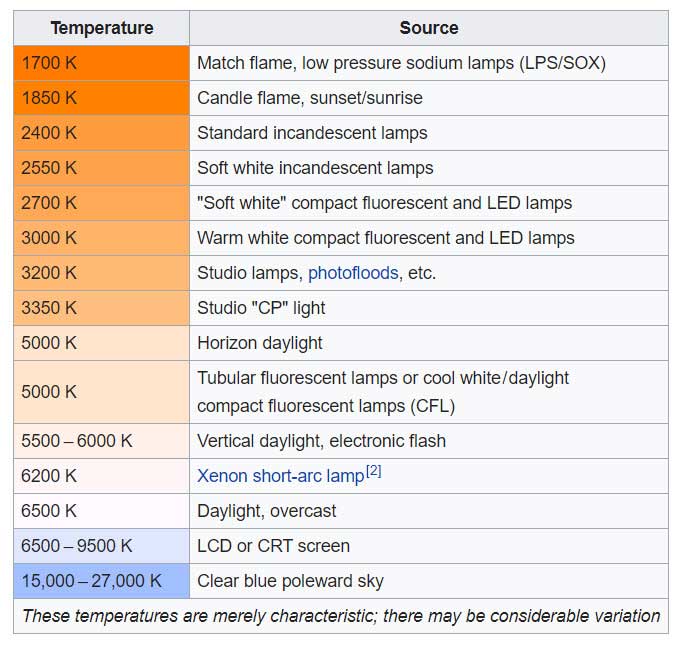
What is Color Temperature?
Okay. So what is color temperature?
Color temperature is a way to measure the color of the light source on the visual spectrum (from infrared to ultraviolet). You don’t really discuss color temperature when talking about fake greens or purple lights because it just doesn’t really make sense.
Lights with a reddish or yellowish hue are said to be ‘warmer,’ while lights with a blueish hue are said to be ‘cooler.’
As the color of the light reflects off of the thing they are working on, that thing will look different colors.
Here’s an illustration with the same room and the same set of furniture with different color temperature lights. Warmer lights give everything a more yellowish hue, and it takes on a brighter white hue in cooler lights.
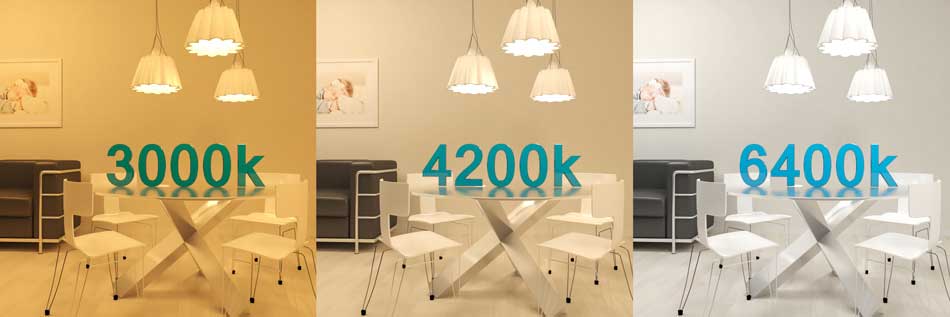
Even though color temperature is measured in ‘degrees Kelvin’ (what we call absolute temperature), it’s not a measure of temperature at all. It’s actually a measure of electromagnetic radiation.
You’ll often see color temperature incorrectly described as the color that a piece of metal (usually iron) gets as it gets hotter.
While this is a great example to help you get the idea, it describes the the concept of ‘red heat’ and not color temperature.
For example, iron will not show a warm red or yellow color at 3000 Kelvin.
It won’t show any color.
It’ll be a gas at that temperature. :)
Cool White or Daylight for Garages?
So why is color temperature important in the garage?
From your own experience, you know that different colored lights make you feel different ways.
We’re more alert with natural, bright light than candlelight.
Studies have shown that brighter lighting with cooler garage light color temperatures caused noticeable increases in attention and memory. By contrast, warmer lighting caused subjects to feel more relaxed.
In fact, warmer lights (around 3000K) actually increase your chances of dozing off. (source)
As we move towards cooler color temperatures, lights take on a more bluish hue, bringing things into sharper focus.
Natural daylight is the equivalent of 6500K. Higher than 6500K, that sharpness actually begins to hurt our eyes.
If you’re setting up a garage workshop you’re going to be in for long periods, try to find that happy medium between lights that make you fall asleep and lights that won’t hurt your eyes.
3000K vs. 5000K Lights: What’s The Difference?
3000K lights provide a warm yellow light, ideal for creating a soft, cozy ambiance. They are gentle on the eyes, containing very little blue light.
In contrast, 5000K lights offer a more neutral, white light with a slight blue tint. This garage light color temperature is brighter and crisper, enhancing visibility for detail-oriented tasks.
3000K lights are typically used in spaces where a relaxing and inviting atmosphere is desired, such as homes and spas. Meanwhile, 5000K lights are more common in workspaces like surgeries, exam rooms, and workshops, where clear and bright lighting is essential.
When Should I Use 3000K Lights?
When we’re talking about garage lighting, 3000K lights are good enough for garages used primarily for parking and storage. The warm light creates a comfortable environment, reducing eye strain for general, non-detailed activities.
When Should I Use 5000K Lights?
5000K lights are ideal for garages serving as workshops or studios. The bright and crisp light aids in tasks requiring precision and attention to detail. They’re also beneficial to keep the room well-lit and safe for detailed and intricate work.
3000K vs. 4000K Lights: What’s The Difference?
3000K and 4000K lights have very similar color temperatures, appearing yellow to the human eye.
3000K lights emit a darker yellow light, creating a warm and relaxing ambiance. 4000K lights, however, are whiter with a hint of yellow, providing a balance between warmth and increased visibility.
When Should I Use 3000K Lights?
As mentioned previously, 3000K lights are perfect for garages used mainly for storage or parking, where a warm, inviting light is preferred. Their yellowish-white color is easy on the eyes, making them suitable for garages that double as relaxation or hobby areas without needing intense focus.
When Should I Use 4000K Lights?
4000K lights are more suitable for garages used as functional workspaces, like for hobbies or DIY projects. The slightly brighter light enhances visibility without being too harsh, making it ideal for tasks like carpentry or detailed work requiring comfort and clarity.
What’s The Difference Between 2700K and 5000K Lights?
2700K lights are on the warmer end of the spectrum, emitting a color similar to typical incandescent bulbs. They create a comfortable, cozy atmosphere.
In contrast, 5000K lights are closer to ‘daylight’ on the spectrum, offering a brighter, more neutral light with a slight blue tint, resembling horizon-level daylight.
When Should I Use 5000K Lights?
5000K lights are ideal for garages used for practical tasks, like parking cars, storing tools, or engaging in detailed work. They provide ample light for safety and clarity, making them suitable for home gyms or workshops within the garage. The brightness of 5000K light stimulates alertness, which is crucial for exercise or detailed creative tasks.
When Should I Use 2700K Lights?
2700K lights are better suited for garages converted into recreational spaces like lounges, reading areas, or entertainment rooms. Their warm glow creates a relaxing environment, reducing eye strain during activities like reading or socializing. For garages transformed into multi-functional spaces, 2700K lights offer a softer, more inviting ambiance.
What’s the Best Color Temperature for Garage Lighting?
It’s a significant investment to upgrade the lighting in your garage – both in time and money.
It’s easy to tell when lights have the wrong color temperature but harder to tell what the right color temperature is.
What I mean is you’ll instantly know that you’ve got the wrong lighting.
Something will be…off.
I’ve compiled some advice from experts and weekend warriors alike to make sure you’ve got the best color temperature for garage lighting, no matter how you use your garage.
General Recommendations (For Most Garages)
Generally speaking, a garage light color temperature between 4000-5000 Kelvin is ideal, depending on your tastes.
When I was a kid, we used incandescent lights in my house, so lights around 3500K – 4000K were ‘normal.’
Through the years, home lighting has gradually moved towards a cooler, whiter light, so the warmer lights we grew up with will seem out of place.
You can get by with any color temperature if you’re just using your garage for storage. Although, it’s worth noting that bright lighting helps keep bugs and spiders out of your garage.
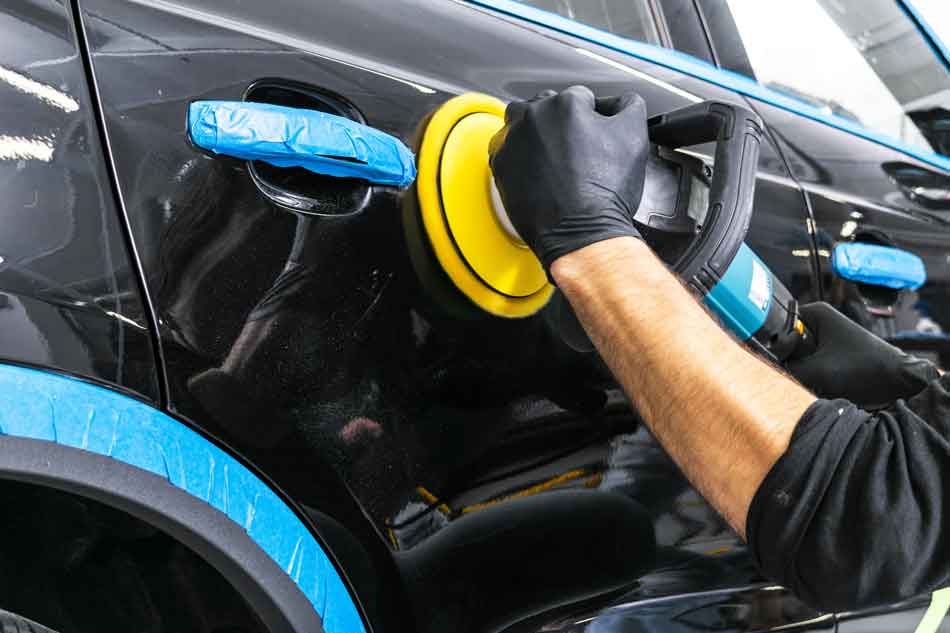
Best Color Temperature for Detailing Your Car
Your car’s in the sun a lot, so it makes sense to have lights with a similar color temperature for detailing. You want to clearly see any smudges or imperfections so you can take care of them.
Here’s a catch-22: The best light source you can get for detailing your car is natural sunlight, but all the experts say you should never wash your car in direct sunlight.
In the same way that we wouldn’t want to be outside for hours on end, we also don’t want to work in a garage with high color temperature lighting for hours.
It just puts too much stress on our eyes.
Experts recommend between 5000K and 6000K color temperatures for detailing your car. If you’re a professional detailer, go with the 6000K lights. If you’re a weekend warrior, go with the 5000K lights overhead and some smaller 6000K lights for detail work.
Matt from Obsessed Garage says: “We’re so conditioned to see a more yellow (light) that it almost looks artificial. But when you’re looking at paint…I prefer it to looking at a more artificial 3500-4000 Kelvin that you’d normally do. It’s a whole lot whiter.”
Not only do you want something with a high color temperature to mimic natural daylight, but you also want something with high color accuracy.
The placement of lights is also a major factor here. You want something that has full body coverage of your car.
However, there’s more to getting great lighting for detailing your car than just picking the right color temperature. Thankfully, I’ve written a guide to that as well.
You can check it out at the link above to see my recommendations and what I use in my garage!
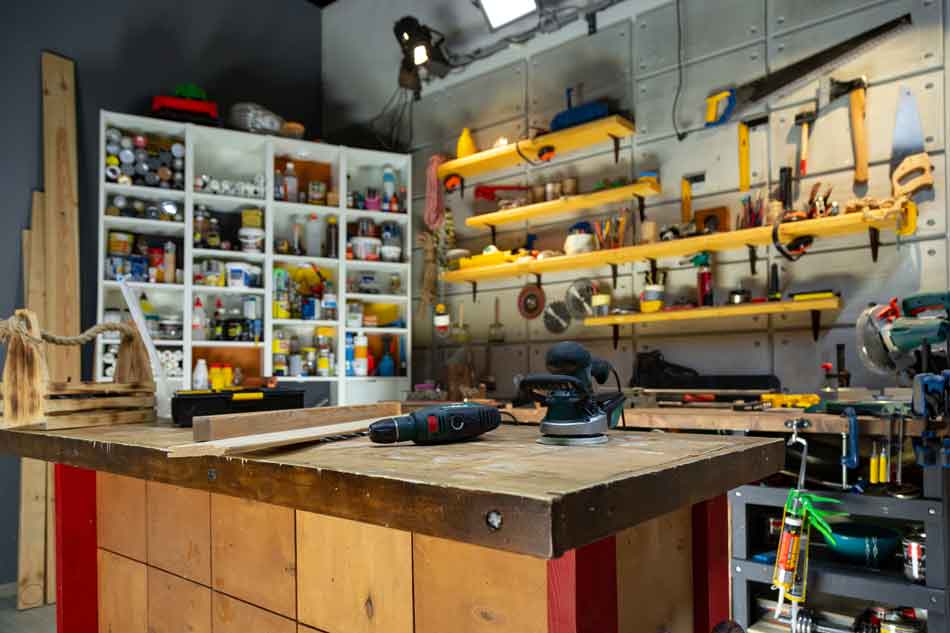
Best Color Temperature for Garage Woodworking Shops
To really bring out the natural hues of the woods, you want lighting that mimics the light in your home but with some additional lighting for detail tasks.
As more homes shift to cooler lighting, shop lighting has also shifted. Woodworkers have moved from 2700K incandescent bulbs to cooler LEDs, so look for lighting between 3500K and 4000K.
Jack from SawMill Creek believes lighting is a personal preference, especially for woodworkers. He recommends seeing different lights in person to get an idea of how they’ll look in your shop.
“If you can’t find a display and don’t already have a preference, 3500K is somewhat neutral and not a bad place to start. “
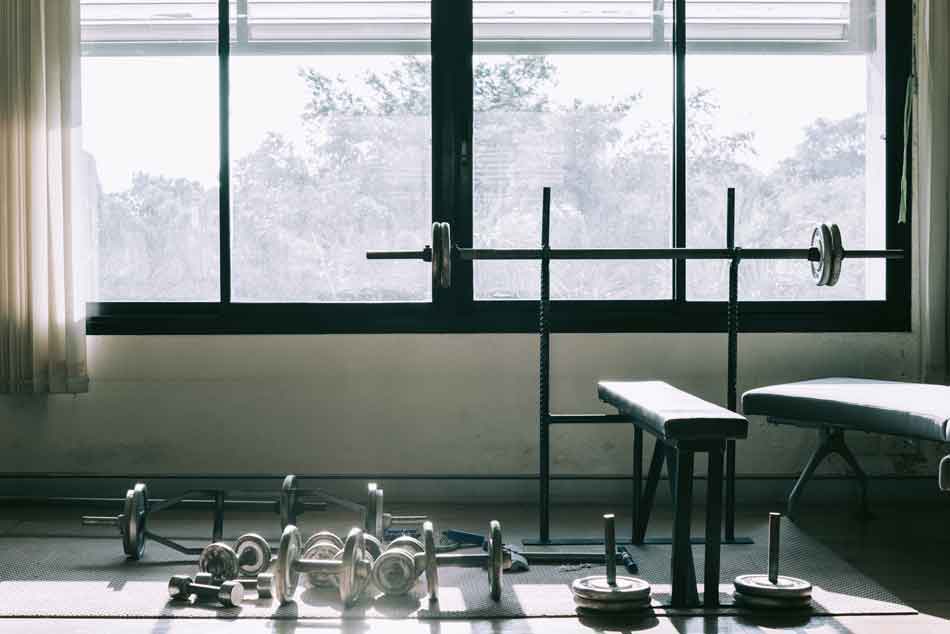
Best Color Temperature for Garage Gyms
Think about the last time you went to the gym.
Was it bright or dark?
Every gym I’ve ever been to has had so many lights that it feels like the treadmill is on the surface of the sun. Come to think of it, I can’t remember ever seeing a dark gym.
The reason is that our bodies respond better to exercise when we’re awake and alert.
Good lighting helps push us and get the most out of our workouts.
Tim from GymCrafter explains it like this: If you can’t get sunshine inside your gym, you should have one overarching goal: “To use lighting that is as close to sunlight as possible in amount, direction, and color.”
That means the best color temperature for garage growhouses is 5000K. This lighting is as close to the mid-day sun as possible. Avoid either yellowish or blueish lighting in hue because it will adversely affect your workout performance.

Best Color Temperature for Garage Grow Rooms
I’ll admit to being out of my element here. I jokingly say that I have a black thumb when it comes to growing any kind of vegetation.
So I turned to Johnny’s Seeds, a privately-held seed producer in Maine, for their advice.
“As a general recommendation, choose a full spectrum grow light with a color temperature in the blue range (5000K – 7000K) to promote vegetative growth and choose a color temperature in the red range (3500K – 4500K) to promote fruiting and flowering.”
Wrapping It Up
We all want our garage to be where we can work, play, or work out. Choosing the proper garage lighting can make all the difference in the world.
When researching garage lighting, it takes a lot of work to get good color temperature recommendations. I wanted to know, in simple terms, what the best lighting was for whatever I wanted to do with my garage.
I hope that this article makes your journey a little easier.
Once you’ve selected the right color temperature, the next step is to find the best LED shop lights. Check out my super-detailed guide to garage lighting for more tips!
